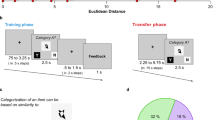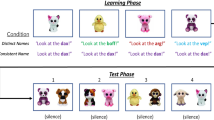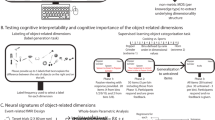Abstract
The cognitive and neural mechanisms underlying category-specific knowledge remain controversial. Here we report that, across multiple tasks (viewing, delayed match to sample, naming), pictures of animals and tools were associated with highly consistent, category-related patterns of activation in ventral (fusiform gyrus) and lateral (superior and middle temporal gyri) regions of the posterior temporal lobes. In addition, similar patterns of category-related activity occurred when subjects read the names of, and answered questions about, animals and tools. These findings suggest that semantic object information is represented in distributed networks that include sites for storing information about specific object attributes such as form (ventral temporal cortex) and motion (lateral temporal cortex).
This is a preview of subscription content, access via your institution
Access options
Subscribe to this journal
Receive 12 print issues and online access
$209.00 per year
only $17.42 per issue
Buy this article
- Purchase on Springer Link
- Instant access to full article PDF
Prices may be subject to local taxes which are calculated during checkout




Similar content being viewed by others
References
Caramazza, A. & Shelton, J. R. Domain-specific knowledge systems in the brain: the animate-inanimate distinction. J. Cogn. Neurosci. 10, 1–34 (1998 ).
Forde, E. M. E. & Humphreys, G. W. Category-specific recognition impairments: a review of important case studies and influential theories. Aphasiology 13, 169– 193 (1999).
Perani, D. et al. Different neural systems for recognition of animals and man-made tools. Neuroreport 6, 1637– 1641 (1995).
Martin, A., Wiggs, C. L., Ungerleider, L. G. & Haxby, J. V. Neural correlates of category-specific knowledge. Nature 379, 649–652 (1996).
Damasio, H., Grabowski, T. J., Tranel, D., Hichwa, R. D. & Damasio, A. R. A neural basis for lexical retrieval. Nature 380, 499–505 (1996).
Tranel, D., Damasio, H. & Damasio, A. R. A neural basis for the retrieval of conceptual knowledge. Neuropsychologia 35, 1319– 1327 (1997).
Pietrini, V. et al. Recovery from herpes simplex encephalitis: selective impairment of specific semantic categories with neuroradiological correlation. J. Neurol. Neurosurg. Psychiatry 51, 1284– 1293 (1988).
Sartori, G., Miozzo, M. & Job, R. Category specific naming impairments? Yes. Q. J. Exp. Psychol. A 46, 489–509 ( 1993).
Gainotti, G., Silveri, M. C., Daniele, A. & Giustolisi, L. Neuroanatomical correlates of category-specific impairments: a critical survey. Memory 3, 247–264 (1995).
Bookheimer, S. Y., Zeffiro, T. A., Blaxton, T., Gaillard, W. & Theodore, W. Regional cerebral blood flow during object naming and word reading. Hum. Brain Mapp. 3, 93–106 (1995).
Price, C. J., Moore, C. J., Humphreys, G. W., Frackowiak, R. S. & Friston, K. J. The neural regions sustaining object recognition and naming. Proc. R. Soc. Lond. B Biol. Sci. 263, 1501–1507 ( 1996).
Büchel, C., Price, C. & Friston, K. A multimodal language region in the ventral visual pathway. Nature 394, 274–277 (1998).
Vandenberghe, R., Price, C. J., Wise, R., Josephs, O. & Frackowiak, R. S. J. Functional anatomy of a common semantic system for words and pictures. Nature 383, 254– 256 (1996).
Ricci, P. T. et al. Functional neuroanatomy of semantic memory: Recognition of semantic associations. Neuroimage 9, 88– 96 (1999).
Mummery, C. J., Patterson, K., Hodges, J. R. & Wise, R. Retrieving "tiger" as an animal name or a word beginning with T: Differences in brain activation. Proc. R. Soc. Lond. B Biol. Sci. 263, 989–995 (1996).
Mummery, C. J., Patterson, K., Hodges, J. R. & Price, C. J. Functional neuroanatomy of the semantic system: divisible by what? J. Cogn. Neurosci. 10, 766–777 (1998).
Cappa, S. F., Perani, D., Schnur, T., Tettamanti, M. & Fazio, F. The effects of semantic category and knowledge type on lexical-semantic access: A PET study. Neuroimage 8, 350–359 (1998).
Perani, D. et al. Word and picture matching: a PET study of semantic category effects. Neuropsychologia 37, 293– 306 (1999).
Moore, C. J. & Price, C. J. A functional neuroimaging study of the variables that generate category-specific object processing differences. Brain 122, 943–962 (1999).
Puce, A., Allison, T., Asgari, M., Gore, J. C. & McCarthy, G. Differential sensitivity of human visual cortex to faces, letter strings, and textures: a functional magnetic resonance imaging study. J. Neurosci. 16, 5205– 5215 (1996).
Clark, V. P. et al. Functional magnetic resonance imaging (fMRI) of human visual cortex during face matching: a comparison with positron emission tomography (PET). Neuroimage 4, 1– 15. (1996).
Kanwisher, N., McDermott, J. & Chun, M. M. The fusiform face area: a module in human extrastriate cortex specialized for the perception of faces. J. Neurosci. 17, 4302–4311 (1997).
McCarthy, G., Puce, A., Gore, J. C. & Allison, T. Face-specific processing in the human fusiform gyrus. J. Cogn. Neurosci. 9, 605–610 (1997).
Haxby, J. V. et al. The effect of face inversion on activity in human neural systems for face and object perception. Neuron 22, 189–199 (1999).
Epstein, R. & Kanwisher, N. A cortical representation of the local visual environment. Nature 392, 598 –601 (1998).
Aguirre, G. K., Zarahn, E. & D'Esposito, M. An area within human ventral cortex sensitive to "building" stimuli: evidence and implications. Neuron 21, 373–383 (1998).
Polk, T. A. & Farah, M. J. The neural development and organization of letter recognition: Evidence from functional neuroimaging, computational modeling, and behavioral studies. Proc. Natl. Acad. Sci. USA 95, 847–852 (1998 ).
Ishai, A., Ungerleider, L. G., Martin, A., Schouten, J. L. & Haxby, J. V. Distributed representation of object form in the human ventral visual pathway. Proc. Natl. Acad. Sci. USA 96, 9379–9384 ( 1999).
Martin, A., Ungerleider, L. G. & Haxby, J. V. in The Cognitive Neurosciences (ed. Gazzaniga, M. S.) (MIT Press, Cambridge, Massachusetts, in press).
Ungerleider, L. G. & Haxby, J. V. 'What' and 'Where' in the human brain? Curr. Opin. Neurobiol. 4, 157–165 (1994).
McNeil, J. E. & Warrington, E. K. Prosopagnosia: A face-specific disorder. Q. J. Exp. Psychol. A. 46A, 1– 10 (1993).
Farah, M. J. Patterns of co-occurrence among the associative agnosia: Implications for visual object representation. Cognit. Neuropsychol. 3, 25–41 (1991).
Bonda, E., Petrides, M., Ostry, D. & Evans, A. Specific involvement of human parietal systems and the amygdala in the perception of biological motion. J. Neurosci. 16, 3737– 3744 (1996).
Puce, A., Allison, T., Bentin, S., Gore, J. C. & McCarthy, G. Temporal cortex activation in humans viewing eye and mouth movements. J. Neurosci. 18, 2188– 2199 (1998).
Perrett, D. I. et al. Social signals analyzed at the cell level: someone is looking at me, something touched me, something moved! Int. J. Comp. Psychol. 4, 25–54 ( 1990).
Oram, M. W. & Perrett, D. I. Responses of anterior superior temporal polysensory (STPa) neurons to "biological motion" stimuli. J. Cogn. Neurosci. 6, 99–116 (1994).
Zeki, S. et al. A direct demonstration of functional specialization in human visual cortex. J. Neurosci. 11, 641– 649 (1991).
Wise, R. et al. Distribution of cortical neural networks involved in word comprehension and word retrieval. Brain 114, 1803– 1817 (1991).
Fiez, J. A., Raichle, M. E., Balota, D. A., Tallal, P. & Petersen, S. E. PET activation of posterior temporal regions during auditory word presentation and verb generation. Cereb. Cortex 6, 1–10 ( 1996).
Martin, A., Haxby, J. V., Lalonde, F. M., Wiggs, C. L. & Ungerleider, L. G. Discrete cortical regions associated with knowledge of color and knowledge of action. Science 270, 102–105 ( 1995).
Sheridan, J. & Humphreys, G. W. A verbal-semantic category-specific recognition impairment. Cognit. Neuropsychol. 10, 143–184 (1993).
Laiacona, M., Capitani, E. & Barbarotto, R. Semantic category dissociation: a longitudinal study of two cases. Cortex 33, 441– 461 (1997).
Funnell, E. & De Mornay Davies, P. JBR: A reassessment of concept familiarity and a category-specific disorder for living things. Neurocase 2, 461–474 ( 1997).
Samson, D., Pillon, A. & De Wilde, V. Impaired knowledge of visual and non-visual attributes in a patient with a semantic impairment for living entities: a case of true category-specific deficit. Neurocase 4, 273–290 (1998).
Thompson-Schill, S. L., Aguirre, G. K., D'Esposito, M. & Farah, M. J. A neural basis for category and modality specificity of semantic knowledge. Neuropsychologia 37, 671– 676 (1999).
Grabowski, T. J., Damasio, H. & Damasio, A. R. Premotor and prefrontal correlates of category-related lexical retrieval. Neuroimage 7, 232– 243 (1998).
Grafton, S. T., Fadiga, L., Arbib, M. A. & Rizzolatti, G. Premotor cortex activation during observation and naming of familiar tools. Neuroimage 6, 231–236 ( 1997).
Friston, K. J. et al. Analysis of fMRI time-series revisited. Neuroimage 2, 45–53 (1995 ).
Haxby, J. V., Maisog, J. M. & Courtney, S. M. in Mapping and Modeling the Human Brain (eds. Lancaster, J., Fox, P. & Friston, K.) (Wiley, New York, in press).
Talairach, J. & Tournoux, P. Co-Planar Stereotaxic Atlas of the Human Brain (Thieme, New York, 1988).
Acknowledgements
We thank Leslie Ungerleider for comments and Jill Weisberg and François Lalonde for technical assistance.
Author information
Authors and Affiliations
Corresponding author
Rights and permissions
About this article
Cite this article
Chao, L., Haxby, J. & Martin, A. Attribute-based neural substrates in temporal cortex for perceiving and knowing about objects. Nat Neurosci 2, 913–919 (1999). https://doi.org/10.1038/13217
Received:
Accepted:
Issue Date:
DOI: https://doi.org/10.1038/13217
This article is cited by
-
Altered gray matter volume in children with newly diagnosed type 1 diabetes mellitus
Pediatric Research (2023)
-
High-dimensional topographic organization of visual features in the primate temporal lobe
Nature Communications (2023)
-
Sex-dependent changes in emotional memory associated with cerebral blood flow alterations during Alzheimer’s disease progression
Neuroradiology (2023)
-
Stop affordance task: a measure of the motor interference effect
Cognitive Processing (2023)
-
The role of the anterior temporal cortex in action: evidence from fMRI multivariate searchlight analysis during real object grasping
Scientific Reports (2022)



